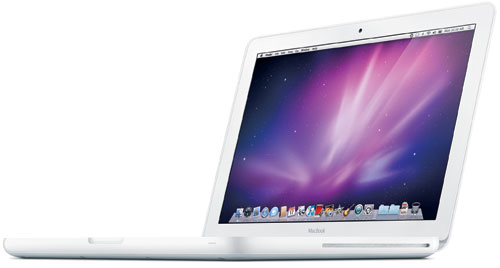Hosted by site sponsor WebMate.
White Unibody MacBook Q&A - Updated January 15, 2013
To be notified of new Q&As, sign up for EveryMac.com's bimonthly email list.
How do you upgrade the hard drive in the White "Unibody" MacBook? Do these models support an SSD?
Please note that this Q&A explains how to upgrade or replace the hard drive in the White "Unibody" MacBook models shipped from 2009 to 2010 (model number A1342).
EveryMac.com also provides hard drive upgrade instructions for the "White & Black" MacBook models shipped from 2006 to 2009 (model number A1181) and the Aluminum "Unibody" MacBook models shipped in 2008 (which share the A1278 model number with many other systems).
There are two different White "Unibody" MacBook models -- the MacBook "Core 2 Duo" 2.26 13" (White Polycarbonate Unibody/Late 2009) and MacBook "Core 2 Duo" 2.4 13" (Mid-2010) -- but the hard drive upgrade procedure is the same for both models. It isn't as simple to upgrade the hard drive in these models as it is for the earlier "pre-Unibody" White or Black MacBook models, but it still is fairly easy.

Photo Credit: Apple, Inc. (White "Unibody" MacBook)
Identification Help
If you're not sure whether or not you have a White "Unibody" MacBook or an earlier system, these models can be externally identified by the A1342 Model Number on the gray rubber bottom of the notebook toward the hinge in tiny type. For the purpose of upgrading or replacing the hard drive, this single identifier is sufficient for identification.
However, these models also can be easily identified by the Model Identifier in software. To locate the model identifier, select "About This Mac" under the Apple Menu on your computer and click the "More Info..." button. If the MacBook is running OS X 10.7 "Lion" or later, you will need to click the "System Report" button after clicking "More Info..." as well.
Useful identifiers for these MacBook models include:
Unibody MacBook |
Subfamily |
Model ID |
Model Number |
Late 2009 |
|||
Mid-2010 |
More details about specific identifiers are provided in EveryMac.com's extensive Mac Identification section.
EveryMac.com's Ultimate Mac Lookup feature also can uniquely identify these systems by their Serial Numbers, and this is another method that can be used to pinpoint the precise model.
Hard Drive Type & SSD Replacement Options
Apple provides hard drive upgrade instructions for these models on pages 37-45 of the User's Guides for both the Late 2009 and Mid-2010 systems. Apple starts by explaining:
You can upgrade the hard disk drive in your MacBook. When you open the back of your MacBook, the hard disk drive is located next to the built-in battery. The replacement drive must be a 2.5-inch drive with a Serial ATA (SATA) connector.
More specifically, the White "Unibody" MacBook models each support a 2.5" notebook hard drive or SSD that is up to 9.5 mm tall (0.37 inches). Each uses the same 3 Gb/s SATA interface, sometimes referred to as SATA 2.0 or SATA II.
The 3 Gb/s SATA standard is backwards compatible with the earlier 1.5 Gb/s SATA (SATA 1.0) standard, and you may install a 1.5 Gb/s SATA drive in these models as well, although it will run at the slower speed. To maximize performance, it is best to install a 3 Gb/s SATA SSD.
Hard Drive Upgrade Instructions
The User's Guides provide detailed instructions, complete with drawings, which absolutely should be read in their entirety before one upgrades or replaces the hard drive.
However, even better, site sponsor Other World Computing provides a convenient step-by-step video of the process:
After watching the video, it should be clear that upgrading the hard drive in this model is not too difficult. However, if you do not feel comfortable -- or have the time -- to perform the upgrade yourself, hiring a professional always is a good option.
MacBook Hard Drive or SSD Purchase Options
In theory, just about any hard drive or SSD that meets the minimum requirements should work in the MacBook. However, it always is best to buy from a trusted company with Mac knowledge for the most trouble-free experience.
In the US (and many other countries), site sponsor Other World Computing sells storage upgrades in addition to memory for the White "Unibody" MacBook models (and all other Macs as well).
In the UK and Ireland, site sponsor Flexx sells MacBook compatible SSDs with free shipping. The company provides flat rate shipping to France, Germany, and Switzerland and inexpensive shipping for all of Europe, too.
Also see:
- How do you upgrade the RAM in the White "Unibody" MacBook models? What type of RAM do they use? How much RAM do they actually support?
- How do you upgrade the hard drive in the "White & Black" MacBook models? Do these models support an SSD?
- How do you upgrade the hard drive in the Aluminum "Unibody" non-Pro MacBook? Does this model support an SSD?
Permalink | Report an Error/Typo | Sign Up for Site Update Notices
<< White Unibody MacBook Q&A (Main)
Established in 1996, EveryMac.com has been created by experts with decades of experience with Apple hardware. EveryMac.com includes, and always has included, original research incorporating detailed, hands-on inspection of packaging, computers, and devices as well as extensive real-world use. All information is provided in good faith, but no website or person is perfect. Accordingly, EveryMac.com is provided "as is" without warranty of any kind whatsoever. EveryMac.com, and the authors thereof, shall not be held responsible or liable, under any circumstances, for any damages resulting from the use or inability to use the information within. For complete disclaimer and copyright information please read and understand the Terms of Use and the Privacy Policy before using EveryMac.com. Copying, scraping, or use of any content without expressed permission is not allowed, although links to any page are welcomed and appreciated.
